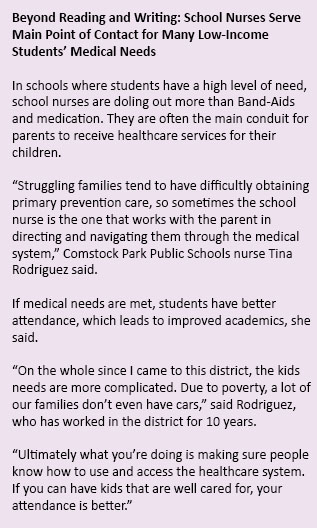Editor’s Note: The Burden of Poverty: A Backpack of Heartache is a continuing series examining the problems poverty creates for students and their families, plus the schools and strategies that are helping disadvantaged students succeed
Fluoride flavor was a concern for Analashia Reid, a Wyoming Public Schools West Elementary second grader, during her recent dental cleaning.
“It’s bubblegum,” said, Jeanette VanOeffelen a dental hygienist.
“I like bubblegum,” said a reassured Analashia, hoping to avoid mint flavor.
At West Elementary School alone, 320 of about 600 students, recently received full dental exams, x-rays, cleaning services, fluoride treatments and, if needed, sealants, through Cherry Health, a non-profit community health organization that has provided free dental care to students since 1992.
See the SNN Series on Poverty: The Burden of Poverty: A Backpack of Heartache
Eight teams of hygienists, dentists and assistants treat 13,000 students per year at 72 schools in Wyoming, Cedar Springs, Comstock Park, Godfrey Lee, Godwin Heights, Grand Rapids, Kelloggsville and Kentwood public schools. Dentists offer exams and x-rays, and hygienists and assistants return about two weeks later.
“Pretty much, they get everything,” said Laura Bloom, dental assistant.
The organization, formerly called Cherry Street Health Services, serves districts that have high free- and reduced- lunch populations, though all students can receive services regardless of income. The organization bills insurance companies if students have coverage.
Students who need further dental work are referred to Cherry Health clinics, which offers dental care at several sites. The mission: improving children’s health, which translates to more success in school.
“If a child has a toothache, he or she is not testing, sleeping or eating well,” Peggy Betzinger, director of the school link health program for the organization.
Dental Needs are High
For economically disadvantaged families, who otherwise might never see a dentist, the service is not just a money-saver, it is saving their children’s teeth.“There are striking disparities in dental disease by income,” Betzinger said. “Poor children suffer twice as much dental caries (decay or cavities) than their more affluent peers.”
Also, uninsured children are 2.5 times less likely than insured to receive dental care, and children from families without dental insurance are three times more likely to have dental needs.
“Parents just don’t have insurance, money, time or transportation,” Bloom said.
When first visiting schools, some students’ teeth are riddled with cavities. Other ailments are painful abscesses and broken teeth. But after visiting repeatedly, the hygienists see improvement. Sealants are a huge help, Bloom said.
“When we start seeing the kids in kindergarten or preschool, that takes care of a lot of the decay problems,” Bloom said.
In Godwin Height Public Schools, Superintendent William Fetteroff said 803 students, more than one third of the student population, received services last school year. Of those, 466 of needed follow-up treatment. This equates to 793 cleanings, 1067 sealants, 65 urgent cases and 466 referrals, he said.
“This means that for almost 25 percent of our student population, this is the only dental services they ever receive,” he said.
Pediatric dental disease is the most common chronic childhood disease, five times more common than asthma and seven times more common than hay fever, Betzinger said. Proper home care is crucial. Hygienists teach students how to brush and floss properly.
“Sometimes kids tell us they don’t have toothbrushes at home,” VanOeffelen said. “If mom and dad don’t have good teeth, they aren’t going to spend time on it with their child, so we like to stress the importance of it.”
Students are given baggies filled with a toothbrush, toothpaste, floss and a letter to their parents.
Better Teeth, Fewer Absences
Mobile services are very attractive to families. When children leave school for dental care, absences add up. Many miss entire school days for dentist appointments, especially those with limited transportation. More than 51 million school hours are lost each year to dental-related illness, Betzinger said.
“The biggest thing is it keeps the kids in school where they need to be. It definitely
 The Cherry Street Dental team works hard to make students feel comfortable and not afraid.
The Cherry Street Dental team works hard to make students feel comfortable and not afraid.
At West Elementary School, Analashia settled into the the dental chair to have her teeth cleaned and a sealant affixed to a tooth. “You’re doing great,” VanOeffelen said, talking her through the entire process.
She explained the need to brush along the gum line to remove plaque. “If you brush like this, you can keep it all off,” she said, demonstrating the proper technique to the girl. “You have pretty teeth, so you want to keep them that way.”
Cherry Health also recently started vision services, last year providing 3,300 eye exams and glasses to students in need.
CONNECT
School Nurses Serve Main Point of Contact for Many Low-Income Students’ Medical Needs








